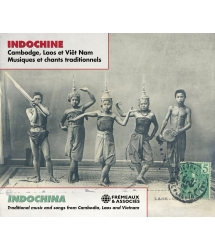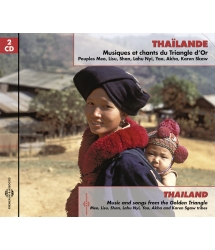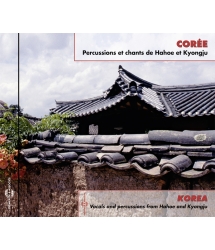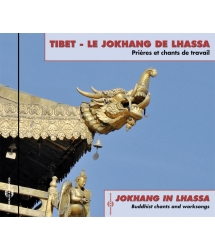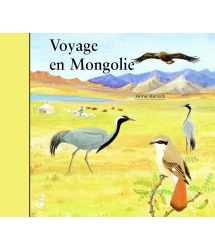- Our Catalog
- Philosophy
- Philosophers of the 20th century and today
- History of Philosophy (PUF)
- Counter-History and Brief Encyclopedia by Michel Onfray
- The philosophical work explained by Luc Ferry
- Ancient thought
- Thinkers of yesterday as seen by the philosophers of today
- Historical philosophical texts interpreted by great actors
- History
- Books (in French)
- Social science
- Historical words
- Audiobooks & Literature
- Our Catalog
- Jazz
- Blues
- Rock - Country - Cajun
- French song
- World music
- Africa
- France
- Québec / Canada
- Hawaï
- West Indies
- Caribbean
- Cuba & Afro-cubain
- Mexico
- South America
- Tango
- Brazil
- Tzigane / Gypsy
- Fado / Portugal
- Flamenco / Spain
- Yiddish / Israel
- China
- Tibet / Nepal
- Asia
- Indian Ocean / Madagascar
- Japan
- Indonesia
- Oceania
- India
- Bangladesh
- USSR / Communist songs
- World music / Miscellaneous
- Classical music
- Composers - Movie Soundtracks
- Sounds of nature
- Our Catalog
- Youth
- Philosophy
- News
- How to order ?
- Receive the catalog
- Manifesto
- Dictionnary











- Our Catalog
- Philosophy
- Philosophers of the 20th century and today
- History of Philosophy (PUF)
- Counter-History and Brief Encyclopedia by Michel Onfray
- The philosophical work explained by Luc Ferry
- Ancient thought
- Thinkers of yesterday as seen by the philosophers of today
- Historical philosophical texts interpreted by great actors
- History
- Books (in French)
- Social science
- Historical words
- Audiobooks & Literature
- Our Catalog
- Jazz
- Blues
- Rock - Country - Cajun
- French song
- World music
- Africa
- France
- Québec / Canada
- Hawaï
- West Indies
- Caribbean
- Cuba & Afro-cubain
- Mexico
- South America
- Tango
- Brazil
- Tzigane / Gypsy
- Fado / Portugal
- Flamenco / Spain
- Yiddish / Israel
- China
- Tibet / Nepal
- Asia
- Indian Ocean / Madagascar
- Japan
- Indonesia
- Oceania
- India
- Bangladesh
- USSR / Communist songs
- World music / Miscellaneous
- Classical music
- Composers - Movie Soundtracks
- Sounds of nature
- Our Catalog
- Youth
- Philosophy
- News
- How to order ?
- Receive the catalog
- Manifesto
- Dictionnary
CHINBAT BAASANKHUU & BAYARBAATAR DAVAASUREN
Ref.: FA5365
EAN : 3561302536521
Artistic Direction : BERNARD FORT
Label : Frémeaux & Associés
Total duration of the pack : 1 hours 5 minutes
Nbre. CD : 1
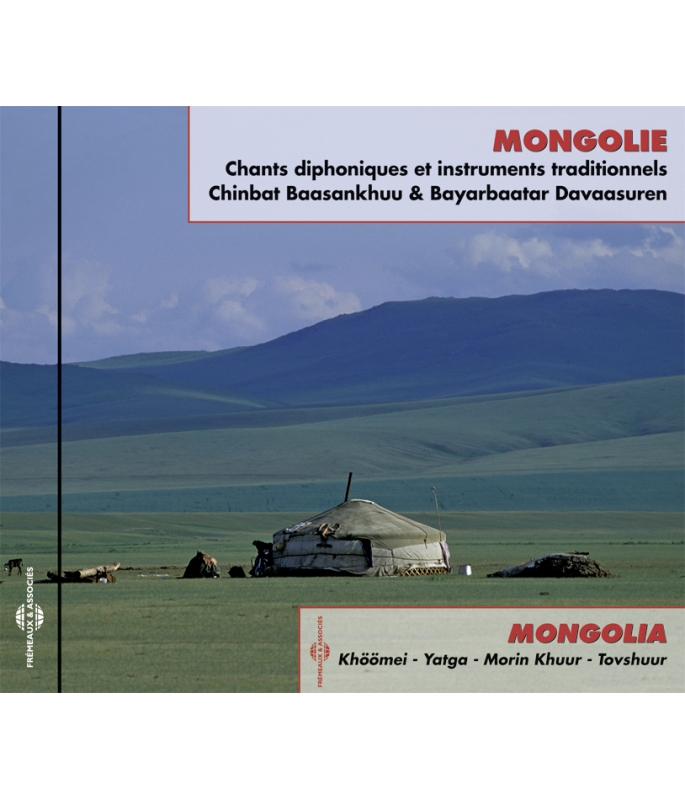
CHINBAT BAASANKHUU & BAYARBAATAR DAVAASUREN
CHINBAT BAASANKHUU & BAYARBAATAR DAVAASUREN
Geography and history define part of Man’s culture. The vast, wind-blown steppes, with yurts scattered here and there, and horsemen bearing their cultural identity, translate into music thanks to vocal techniques unlike any other. According to legend, the Gobi Altaï to the west of this country is the first place where the Khöömii was heard, the famous throat-singing technique specific to Mongolia. Bernard Fort went there to record the two bestknown performers in the Mongolian tradition: Bayarbaatar Davaasuren, today considered one of the greatest Khöömii singers (sometimes accompanying himself on the Morin-Khuur or the Tovshur); and Chinbat Baasankhuu, a Yatga specialist. Benjamin GOLDENSTEIN & Patrick FRÉMEAUX
-
PisteTitleMain artistAutorDurationRegistered in
-
1Avgiin Tsagaan UulChinbat Baasankhuu & Bayarbaatar Davaasuren00:03:202011
-
2Mandah NarChinbat Baasankhuu & Bayarbaatar Davaasuren00:08:402011
-
3Chinggis Khaanii MagtaalChinbat Baasankhuu & Bayarbaatar Davaasuren00:13:052011
-
4Khilen Khariin KhatiraaChinbat Baasankhuu & Bayarbaatar Davaasuren00:04:442011
-
5Khangain MagtaalChinbat Baasankhuu & Bayarbaatar Davaasuren00:06:382011
-
6Sudgiin NogooChinbat Baasankhuu & Bayarbaatar Davaasuren00:04:062011
-
7Oirdiin UriaChinbat Baasankhuu & Bayarbaatar Davaasuren00:04:262011
-
8Tes Goliin MagtaalChinbat Baasankhuu & Bayarbaatar Davaasuren00:04:272011
-
9Zadgai Tsagaan UulChinbat Baasankhuu & Bayarbaatar Davaasuren00:00:352011
-
10Morin Khuuriin TatlagaChinbat Baasankhuu & Bayarbaatar Davaasuren00:02:482011
-
11Variations sur une mélodie populaireChinbat Baasankhuu & Bayarbaatar Davaasuren00:09:472011
-
12Manduul Khaanii MagtaalChinbat Baasankhuu & Bayarbaatar Davaasuren00:02:412011
CLICK TO DOWNLOAD THE BOOKLET
FA5365
MONGOLIE
Chants diphoniques et instruments traditionnels
Chinbat Baasankhuu & Bayarbaatar Davaasuren
MONGOLIA
Khöömei - Yatga - Morin Khuur - Tovshuur
MUSIQUES DE MONGOLIE
Ce CD a été enregistré par Bernard Fort, en Mongolie et dans les studios du Groupe Musiques Vivantes de Lyon, avec le soutien de Culturesfrance et de la Ville de Lyon.
Merci à Bulgantamir Sangidkhorloo pour son aide aux nombreuses traductions.
Durée totale du CD : 65‘21”
Index 1 : 3’18”
“Avgiin tsagaan uul” (La montagne blanche de Avga) : Khöömei et grand Yatga 21 cordes, Chant traditionnel mongol.
Index 2 : 8’38”
“Mandah nar” (Le lever du soleil) : Grand Yatga 21 cordes, Chant traditionnel mongol adapté au yatga par Chinbat Baasankhuu
Index 3 : 13‘03”
“Chinggis Khaanii Magtaal” (Louange de Gengis Khan) : Khöömei + Morin Khuur, composé par Bayarbaatar Davaasuren.
1. Je voudrais chanter
Louer et me souvenir
Du fond du cœur
De mon Saint Gengis khan
2. Entre les ténèbres de la nuit et l’aurore
Il transhumait souvent
Tellement actif qu’il ne se reposait jamais ;
Il est né de la tribu Borjigon
3. Fils du héros Esukhei descendant du héro Bartan
Le héros fort et de belle apparence
CHINGIS KHAAN KHAAN CHINGIS
4. Il est descendu de l’empire de quatre-vingt dix-neuf cieux
Né divin,
Ayant pouvoir sur tout,
Fils du héros Esukhei, Saint Gengis khan
5. Il vénérait le ciel en brûlant de l’encens
Et unifia son royaume dispersé,
Organisa le grand banquet
Vécut heureux avec tout son peuple.
CHINGIS KHAAN KHAAN CHINGIS.
Index 4 : 4’40”
“Khilen khariin khatiraa” (Le galop du cheval noir velouté) : petit Yatga à 13 cordes, mélodie traditionnelle arrangée pour le Yatga par B. Naranbaatar.
Index 5 : 6’36”
”Khangain magtaal” (Louange de Khanghaï) : Tovshuur + Khöömei, mélodie traditionnelle mongole présentant une forme particulière du chant diphonique.
1. La montagne brune et somptueuse de khangaï se voit de loin
Les fleuves coulent et sillonnent en douceur par ses vallées
La voici
Ma patrie riche Khanghaï, terre jeune et fortunée
2. Cette patrie Kanghaï est assez riche pour offrir le pâturage aux chevaux
Elle est généreuse aussi pour son peuple
La voici
Ma patrie riche Khanghaï, terre jeune et fortunée
3. Quand on monte les montagnes en gravissant les versants
Les aigles noirs au dos clair font la chasse
La voici
Ma patrie riche Khanghaï, terre jeune et fortunée
Index 6 : 4’44”
“Sudgiin nogoo” (Attendant son fiancé) : Grand Yatga 21 cordes, mélodie traditionnelle mongole (adaptation au Yatga Chinbat Baasankhuu)
Index 7 : 4’24”
“Oirdiin Uria” (Thème des Oirats) : Morin Khuur, musique traditionnelle mongole de l’ethnie des Oirats.
Index 8 : 4’25”
“Tes Goliin magtaal” (Louange de la rivière de Tes) : Khöömei + Morin Khuur. Chant traditionnel mongol.
Découlant du devant de Boulnan
Ayant le goût de friandise de Burai
Sillonnant la steppe large,
La rivière de Tes, la fortunée !
Trésors de Tes
Sables de Tes
Soie de Tes
Sacrée Tes
Notre ancêtre, Tes
Elle prolonge le lac de Uvs
A l’allure de l’amble naturel
Elle est la source des familles et du bétail
Trésors de Tes
Sables de Tes
Soie de Tes
Sacrée Tes
Notre ancêtre, Tes
Index 9 : 0’33”
“Zadgai tsagaan uul” (La montagne blanche) : Guimbarde de bois, petite mélodie traditionnelle.
Index 10 : 2’46”
“Morin khuuriin tatlaga : khoton” (mélodie et danse traditionnelle pour Morin-khuur d’origine Khoton) : Morin Khuur.
Index 11 : 9’47”
“Variations sur une mélodie populaire” : Grand Yatga 21 cordes adaptation à l’instrument de Bariat Sharav.
Index 12 : 2’41”
“Manduul khaanii Magtaal ” (Eloge de Manduul khan) : Khöömei et grand Yatga 21 cordes
Manduul khan est divin, envoyé du ciel
Divinité de l’Etat mongol
Descendant royal (de Gengis khan) doré
Véritable histoire du peuple mongol
Rit. EMBUU, EMBUU
Tara (déesse bouddhiste) de diamant sacré
Du peuple nomade des steppes vierges
Vénération du ciel étoilé
Grand sutra historique (chronique) béni
Rit. EMBUU, EMBUU, EMBUU
Divinité des ancêtres lointains
Honorées et sacrées dans la montagne Burkhan Khaldun (montagne de la province Kentii, le lieu de naissance de Gengis khan)
Les ascendants de tous les peuples mongols
Descendance dorée de Gengis khan
Ghesar et Diangar (héros des légendes mongoles) sont honorés en langue mongole
La vièle à tête de cheval (le morin-khuur) est un instrument musical divin
Louons la gloire éternelle
Du peuple nomade sous un ciel inaltérable
Rit. EMBUU, EMBUU, EMBUU NA, NA, AI HO…
Le chant diphonique de Mongolie : Khöömei
Nous utilisons le terme diphonique pour définir un chant pratiqué par une seule personne produisant simultanément un bourdon continu et un deuxième son, plus aigu, constitué d’une série d’harmoniques ressemblant au son d’une flûte. Ces harmoniques, isolés par le chanteur grâce à sa cavité buccale, proviennent de la voix de bourdon. Ce chant est exclusivement masculin, pour des raisons plus traditionnelles que physiologiques.
Les instruments
Le Morin-Khuur
Bayarbaatar s’accompagne du Morin-Khuur (littéralement : vielle-cheval), dont il fait sonner les deux cordes, l’une en bourdon et l’autre en accompagnement mélodique de son chant. La principale particularité de l’instrument réside dans les cordes qui ne sont pas faites de boyaux comme cela se rencontre souvent mais d’une mèche de crins de cheval, d’où ce son un peu feutré. De plus, les cordes, tendues loin du manche sonnent “à vide”, ou sont simplement touchées par les doigts de l’interprète, mais jamais mises en contact avec le manche comme cela se pratique sur le violon ou le violoncelle.
Le Morin-Khuur se tient presque verticalement, la caisse de résonance de forme trapézoïdale posée entre les genoux de l’interprète. La tenue de l’archet, lui aussi équipé d’une mèche de crins de cheval, fait penser à celle de notre contrebasse. La tension des crins n’est pas réglée directement par l’archet, mais par la position des mains de l’interprète.
Le Tovshuur
Occasionnellement, Bayarbaatar s’accompagne du Tovshuur, instrument peu sonore à deux cordes pincées dont la petite caisse de résonance possède la forme d’une demi-poire. Les cordes sont faites d’intestin d’animaux séchés et la caisse, légère, est recouverte de peau de chèvre. Le tovshuur est souvent utilisé pour évoquer la nature et les paysages, ou encore les épopées des grands personnages de la Mongolie.
Le Yatga
Chinbat Baasankhuu pratique le Yatga comme instrument soliste ou accompagnateur du chant de Bayarbaatar. De la famille des cithares ou des harpes, ses origines seraient chinoises. Le Yatga, mentionné pour la première fois au 14ème siècle comme instrument de cour, possède des chevalets mobiles sur une table bombée en arc de cercle. L’instrument se pose par terre, sur les genoux du musicien, sur une table ou sur deux chevalets. Chinbat Baasankhuu pince les cordes avec les doigts de la main droite et, de la main gauche, elle fait varier la hauteur des notes, crée différents vibratos ou autres effets sonores. Elle utilise deux instruments : la forme ancienne, très représentative des traditions mongoles, possédant 13 cordes et une forme plus moderne en possédant 21, cette dernière forme se retrouvant dans une grande partie de l’Asie.
La Guimbarde
Il existe un assez grand nombre de guimbardes utilisées avec facilité par les chanteurs de Khöömii, celle ci se trouve aussi en Chine, elle est fabriquée en bambou. Ici la guimbarde est jouée par Bayarbaatar.
LES MUSICIENS
Bayarbaatar DAVAASUREN
Bayarbaatar DAVAASUREN est originaire d’une famille de nomades éleveurs de chameaux et de chevaux dans la région Ouest de Mongolie appelée Gobi Altaï. Point de rencontre géographique entre les montagnes de l’Altaï et l’immense désert de Gobie, cette région est, selon la légende, le premier endroit où l’on entendit le Khöömii, ce fameux chant de gorge diphonique. Très tôt, cet artiste révéla un don pour cet art vocal qu’il va développer tout en apprenant à jouer de la « vièle cheval », le fameux Morin-khur. Il joue également du Tovshuur et de la guimbarde. Sa réputation s’étend rapidement à la capitale Oulan-Bator qui lui décerne un premier prix de chant.
Depuis quelques années, il s’est manifesté en Corée du sud et en Chine (1996), en Russie (1997), en Ukraine (1999), au Japon (1995,1997 et 1998) et en France. En 2000, lors de la biennale de la danse de Lyon, son chant était déjà associé à la musique de Bernard Fort (« L’Impatience des Limites ») dans le spectacle « Loup bleu » de la chorégraphe lyonnaise Kilina Cremona. Depuis le printemps 2007, Bayarbaatar Davaasuren a donné plusieurs récitals de chants diphoniques mongols en France ainsi que le spectacle « Les Chants de l’Altaï » avec Bernard Fort.
Bayarbaatar Davaasuren est aujourd’hui considéré comme l’un des plus grands chanteurs de Khöömii de Mongolie car il exprime avec virtuosité son talent vocal au travers des cinq centres d’émissions spécifiques à ce chant : le ventre, la poitrine, la gorge, la bouche et le nez. Egalement maître de ballet traditionnel, il vient d’être nommé Directeur artistique chorégraphe du Théâtre des Arts Traditionnels d’Oulan Bator (National Song and Dance Academic Ensemble).
Chinbat BAASANKHUU
Chinbat Baasankhuu est née dans la ville d’Altaï située au centre du Gobi Altaï. Après avoir reçu un enseignement en musique et en danse à Zavkhan, puis à Ulan Bator, elle intègre l’Université des Arts et de la Culture de Mongolie où elle se spécialise dans la pratique du Yatga. Elle y obtient son diplôme en 1998 et un an plus tard celui du conservatoire de Shanghai (Chine). Au cours de son apprentissage, elle remporte de très nombreux prix d’interprétation. Sa réputation s’étend jusqu’en Corée, en Chine et au Japon où elle est invitée pour donner ses récitals de Yatga.
En 2002, elle remporte la coupe d’argent du festival de printemps de Corée du Nord. En 2006, son récital intitulé « Soft snow melody » remporte un vif succès à l’auditorium de l’Orchestre National Philharmonique. Ce qui lui vaudra d’être repris un an plus tard par le « Zither’s Ensemble » à la demande de la fondation « Steppe Melody ». Enseignant le Yatga à l’Université des Arts et de la Culture de Mongolie au sein du département des musiques traditionnelles, on lui doit également plusieurs études et écrits sur la pratique du Yatga en Corée et en Mongolie : « Playing method of Korean Gayagum » (2006), « Form and Develop of Mongolian Zither » (2006).
Bernard FORT
© Frémeaux & Associés
BERNARD FORT est co-fondateur et responsable du Groupe Musiques Vivantes de Lyon.
Il enseigne la composition électroacoustique à l’Ecole Nationale de Musique de Villeurbanne, et partage le reste de son temps entre la composition et l’ornithologie. Son travail musical est entièrement consacré au genre acousmatique pour le concert, en salle ou en plein air, la danse, le jeune public. En composition, il s’intéresse depuis toujours aux limites entre abstraction et figuration, naturel et culturel.
Du même auteur chez Frémeaux et Associés :
Le matin des oiseaux • Paysages canadiens • Danube sauvage • Nocturnes du Monde • Les concerts de la nuit • Paysages sonores de Sardaigne • Forêts et Montagnes Corses • Paysages de Pluie • Paysages sonores de Toscane.
MUSIC FROM MONGOLIA
This CD was recorded by Bernard Fort in Mongolia and at the Groupe Musiques Vivantes Studios in Lyon, with the assistance of Culturesfrance and the City of Lyon. With thanks to Bulgantamir Sangidkhorloo for his help with the many translations.
Total playing time: 65’21”
Index 1: 3’18”
“Avgiin tsagaan uul” (The white mountain of Avga): Khöömei throat-singing and the large 21-string Mongolian zither (Yatga), traditional Mongolian song.
Index 2: 8’38”
“Mandah nar” (Sunrise): 21-string Yatga, traditional
Mongolian song adapted for Yatga by Chinbat Baasankhuu.
Index 3: 13’03”
“Chinggis Khaanii Magtaal” (Praise of Genghis Khan): Khöömei + Morin Khuur, composed by Bayarbaatar Davaasuren.
Index 4: 4’40”
“Khilen khariin khatiraa” (The gallop of the velvety black horse): small 13-string Yatga, traditional melody arranged for Yatga by B. Naranbaatar.
Index 5: 6’36”
”Khangain magtaal” (Praise of Khanghaï): Tovshuur + Khöömei, traditional Mongolian melody with a particular form of throat-singing (overtone).
Index 6: 4’44”
“Sudgiin nogoo” (Waiting for her fiancé): 21-string Yatga, traditional Mongolian melody adapted for Yatga by Chinbat Baasankhuu.
Index 7: 4’24”
“Oirdiin Uria” (Oirat theme): Morin Khuur, traditional Mongolian melody of the Oirats ethnic group.
Index 8: 4’25”
“Tes Goliin magtaal” (Praise of the Tes River): Khöömei + Morin Khuur. Traditional Mongolian song.
Index 9: 0’33”
“Zadgai tsagaan uul” (The white mountain): Wooden Jew’s harp. A short traditional melody.
Index 10: 2’46”
“Morin khuuriin tatlaga: khoton” (Melody and traditional dance for the Morin Khuur of the Khoton Mongolians): Morin Khuur.
Index 11: 9’47”
“Variations on a popular melody”: 21-string Yatga, adaptation for Yatga by Bariat Sharav.
Index 12: 2’41”
“Manduul khaanii Magtaal” (Praise of Manduul Khan): Khöömei and 21-string Yatga.
Overtone throat-singing in Mongolia: Khöömei
We use the term overtone singing to define a form of song practised by a single person and which simultaneously produces a continuous bourdon hum and a second, higher sound (overtone resonances), made up of a series of harmonics resembling the sound of a flute. These harmonics, isolated by the singer by reshaping the mouth cavity, come from the «humming» voice. The song is exclusively masculine, for reasons more to do with tradition than physiology.
The instruments
The Morin-Khuur
Bayarbaatar accompanies himself on the Morin-Khuur (literally, «horse-head fiddle»), a traditional Mongolian bowed string-instrument with two strings, one resonating in a low pitch and the other as melodic accompaniment for the song. The instrument’s main specificity lies in the strings, which are made not from the usual gut but from a mane of horse-hair, hence the more muted sound. In addition, the strings are drawn tight some distance from the neck, resonating either “emptily” or when touched by the fingers of the player, but never through contact with the neck as for a violin or cello.
The Morin-Khuur is held almost vertically with the trapezoid-shaped sound-box placed between the player’s knees. The bow, also strung with horse-hair, resembles that of the western world’s contrabass; the hairs are tautened not with the bow itself, but through the positioning of the player’s hands.
The Tovshuur
Bayarbaatar occasionally accompanies himself on the tovshuur, a quieter-sounding instrument with two plucked strings and a midsized sound-box in a half-pear shape. The strings are made of dried animal-gut and the lightweight body is covered with goatskin. The tovshuur is often used to evoke nature and the countryside, or the epic adventures of great Mongolian figures…
The Yatga
Chinbat Baasankhuu plays the Yatga either as a solo instrument or else to accompany the song of Bayarbaatar. The instrument, said to be of Chinese origin, belongs to the zither or harp family. The Yatga was first mentioned in the 14th century as a court-instrument, with a movable bridge over the sounding board in the shape of a convex arc. The instrument is placed on the ground, on the musician’s lap, on a table or on two trestles. Chinbat Baasankhuu plucks the strings with the fingers of her right hand and, with the left, her fingers vary the pitch and create different vibratos or other sounds. She uses two instruments: the ancient form of the Yatga with 13 strings, highly representative of Mongolian traditions, and a more modern form with 21 strings which is widespread in Asia.
The JEW'S HARP
There are many Jew’s harps in existence, all used with great facility by Khöömei singers; this one can also be found in China, and is made from bamboo.
THE MUSICIANS
Bayarbaatar DAVAASUREN
Bayarbaatar DAVAASUREN comes from a family of nomads who raised camels and horses in the western region of Mongolia known as Gobi Altaï. According to legend, this region, a geographical meeting-point between the Altaï Mountains and the immense Gobi Desert, is the first place where Khöömei was heard, the famous form of throat-singing. Bayarbaatar revealed a gift for this vocal technique while quite young and developed the talent while learning to play the famous horse-head fiddle, the Morin-Khuur (he also plays the Tovshuur and the Jew’s harp). His reputation spread rapidly to the capital, Ulan Bator, where he was awarded First Prize for his singing. He has appeared in South Korea and China (1996), Russia (1997), Ukraine (1999), Japan (1995, 1997 and 1998) and in France. At the Lyon Dance Biennial in 200 his song was already associated with the music of Bernard Fort (L’Impatience des Limites) in the Loup bleu show staged by the Lyon choreographer Kilina Cremona. Since spring 2007 Bayarbaatar Davaasuren has given several Mongolian song-recitals in France and appeared with Fort in the show Les Chants de l’Altaï.
Bayarbaatar Davaasuren is today considered one of the greatest Khöömei singers in Mongolia, a virtuoso of the vocal technique which emits song through five specific centres: belly, chest, throat, mouth and nose. Also a Master of traditional ballet, he has just been appointed Artistic Director in Choreography by the Ulan Bator Theatre for Traditional Arts (the Mongolian National Song and Dance Academic Ensemble).
Chinbat BAASANKHUU
Chinbat Baasankhuu was born in Altaï in the centre of the western Gobi Altaï region. After taking lessons in music and dancing in Zavkhan and later Ulan Bator, she attended Mongolia's University of Arts and Culture and became a Yatga specialist. She gained her diploma in 1998 and a year later graduated from the Conservatory of Shanghai in China.
During her apprenticeship she won numerous prizes for her playing, and her reputation spread through Korea, China and Japan, where she was invited to give recitals. In 2002 she won the Silver Cup at North Korea's Spring Festival, and in 2006 her Soft Snow Melody recital at the National Philharmonic Orchestra Auditorium was a triumph; the piece was taken up a year later by the Zither Ensemble at the request of the Steppe Melody Foundation.
Chinbat currently teaches the yatga in the Traditional Music Department of the University from where she graduated, and has published several studies on the practise of her instrument in Korea and Mongolia: Playing method of Korean Gayagum (2006) and Form and Development of Mongolian Zither (2006).
Bernard FORT
Adapted in English by Martin DAVIES
© Frémeaux & Associés
BERNARD FORT is co-founder and director of the Musiques Vivantes Group of Lyon. He teaches electro-acoustic composition at the National Music School in Villeurbanne, dividing the rest of his time between composing and ornithology. His work in music is entirely devoted to the acousmatic genre for concerts both indoor and outdoor, the dance and young audiences. As a composer he has always been interested in the limits between abstraction and figuration, the natural and the cultural.
MONGOLIE - Chants diphoniques et instruments traditionnels MONGOLIA - Khöömei - Yatga - Morin Khuur - Tovshuur
Chinbat Baasankhuu & Bayarbaatar Davaasuren / Réalisation Bernard Fort
La géographie et l’histoire définissent une partie des cultures des hommes. Les vastes steppes balayées par les vents, parsemées de yourtes et sillonnées à cheval ont véhiculé une culture unique qui se traduit en musique par des techniques à nulles autres pareilles.
Le Gobi Altaï, dans l’ouest du pays, est d’après la légende le premier endroit où l’on entendit le Khöömii, ce fameux chant de gorge diphonique spécifique à la Mongolie. Bernard Fort y est allé enregistrer deux des principaux interprètes de la musique traditionnelle mongole : Bayarbaatar Davaasuren, l’un des plus grands chanteurs de Khöömii (qui s’accompagne parfois au Morin-Khuur ou au Tovshur), et Chinbat Baasankhuu, spécialise du Yatga.
Douze titres qui permettent de découvrir, en plus d’une heure, le patrimoine musical centenaire et unique des steppes nomades de Mongolie.
Benjamin Goldenstein & Patrick Frémeaux
Geography and history define part of Man’s culture. The vast, wind-blown steppes, with yurts scattered here and there, and horsemen bearing their cultural identity, translate into music thanks to vocal techniques unlike any other.
According to legend, the Gobi Altaï to the west of this country is the first place where the Khöömii was heard, the famous throat-singing technique specific to Mongolia. Bernard Fort went there to record the two best-known performers in the Mongolian tradition: Bayarbaatar Davaasuren, today considered one of the greatest Khöömii singers (sometimes accompanying himself on the Morin-Khuur or the Tovshur); and Chinbat Baasankhuu, a Yatga specialist.
Benjamin Goldenstein & Patrick Frémeaux
CD MONGOLIE - CHANTS DIAPHONIQUES ET INSTRUMENTS TRADITIONNELS, CHINBAT BAASANKHUU & BAYARBAATAR DAVAASUREN © Frémeaux & Associés 2012 (frémeaux, frémaux, frémau, frémaud, frémault, frémo, frémont, fermeaux, fremeaux, fremaux, fremau, fremaud, fremault, fremo, fremont, CD audio, 78 tours, disques anciens, CD à acheter, écouter des vieux enregistrements, albums, rééditions, anthologies ou intégrales sont disponibles sous forme de CD et par téléchargement.)
